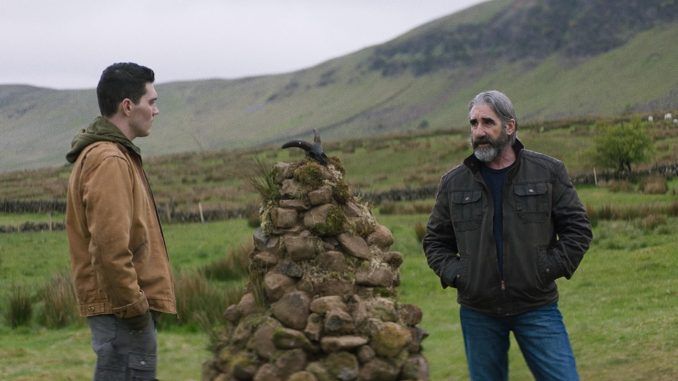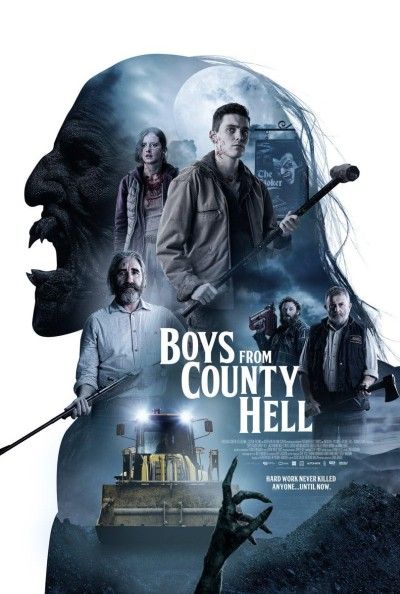
Rating: B-
Dir: Chris Baugh
Star: Jack Rowan, Nigel O’Neill, Louisa Harland, Michael Hough
There is not much going on in the small Irish town of Six Mile Hill. Among the limited set of entertainment options is scamming gullible tourists by playing on the dubious connection between the town and Bram Stoker. For the Irish author was allegedly inspired to write his classic novel, Dracula, after visiting the town. I mean, there’s even a pub called The Stoker. What more evidence could you possibly want? Oh, alright then. On the outskirts of the town is a cairn. Under it, legend says, is Abhartach, a blood-drinking fiend who had terrorized the area, until he was defeated by a local hero, and buried beneath the rocks which stop him arising from the grave.
Two things then propel the narrative. Walking across the field with the cairn, friends Eugene Moffat (Rowan) and William Bogue are attacked by a farmer’s bull. Blood is spilled, and if you’ve seen Hellraiser, you know this is never a good thing in a horror movie. On addition, there’s a bypass being built around the town, and Eugene’s father Francie (O’Neill) has won the contract to clear the ground. Despite qualms from some residents, Eugene demolishes the cairn. If you’ve seen Poltergeist, you’ll know that disturbing an ancient burial site is never a good idea either. Early the next morning, when the Moffats return to the site, they find the cairn has mysteriously been rebuilt, and the night-watchman left to guard the site has gone missing.
 Well, at least initially. When he is found, it is quickly discovered that he is now “a bit bitey”, and also very hard to put down. Eventually, this is done through demolishing the cairn again. Except, this unleashes the far bigger threat of Abhartach, who heads towards Six Mile Hill. The father and son, along with long-suffering pals Claire (Harland) and SP (Hough) suddenly find themselves needing to become vampire hunters, not least because the local authorities i.e. the town’s one policeman, isn’t much help. And neither is Bram Stoker, for it turns out that there’s a large gap between what he describes in his book, and the real thing. For instance, Abhartach doesn’t need to be in the same room to start draining your blood…
Well, at least initially. When he is found, it is quickly discovered that he is now “a bit bitey”, and also very hard to put down. Eventually, this is done through demolishing the cairn again. Except, this unleashes the far bigger threat of Abhartach, who heads towards Six Mile Hill. The father and son, along with long-suffering pals Claire (Harland) and SP (Hough) suddenly find themselves needing to become vampire hunters, not least because the local authorities i.e. the town’s one policeman, isn’t much help. And neither is Bram Stoker, for it turns out that there’s a large gap between what he describes in his book, and the real thing. For instance, Abhartach doesn’t need to be in the same room to start draining your blood…
I think this may be the first Irish vampire movie, though it was subsequently followed down the path by Let the Wrong One In. It certainly offers a fresh location, with an entirely rural setting which reminded me a bit of Lepterica. There is a fair amount of “truth” in the background here. Abhartach is indeed a figure from Irish folklore, and has been suggested by some as an inspiration for Stoker. The tale was originally recorded collected in Patrick Weston Joyce’s 1870 book, The Origin and History of Irish Names of Places, though there’s no actual blood-drinking mentioned there. Indeed, Abhartach here reads almost more as a zombie, coming back from the grave repeatedly until the “trick” of permanent dispatch is found. In this case, it’s a sword made from a yew tree and burying him head-down.
No yew trees are used here. Indeed, among the film’s best scenes is the sequence where our unlikely heroes have to figure out how they can keep the night-watchman down. Even impalement of the most extreme kind proves barely an inconvenience. This is merely a warm-up, for the acolyte is but a pale shadow of the one who created him. To be honest, despite this, the later stages are less impressive. The interplay between the characters is a large part of what had made this work. Nobody is really happy with their lives here, for a variety of reasons. Yet they are held together by affection, even if it’s of the strained, almost obligatory kind, such as between Eugene and his dad.
These elements are more effective than the horror, which eventually descends into the Moffats running around in the near-dark whacking at things. The well-crafted development of the story, which took place over the first hour, ceases to exist and the film ends up limping its way over the line, to a certain extent. There’s a particularly ludicrous finale, that seems to have strayed in from Monty Python – though I will admit, it’s certainly a method of vampire dispatch I have not previously seen. This is a shame, considering the subtler nods to things like An American Werewolf in London which arrived earlier. Much like Baugh’s previous feature, Bad Day for the Cut, it’s the characters that keep you watching, albeit with similar pacing issues.
 You will need a strong ear for the dialogue. Hell, I’m from a Celtic background myself, and even I struggled to make out some of the lines. That’s simply due to the heavy accents sported by some characters, combined with their fast delivery, rather than any audio flaws. Indeed, the technical elements are good, outside of the underlit nature of some scenes. The lush Irish countryside gets an attractive presentation, to the point Chris wondered if we should consider moving to the Emerald Isle. “It probably rains a lot there,” she concluded, though the weather here is almost suspiciously pleasant.
You will need a strong ear for the dialogue. Hell, I’m from a Celtic background myself, and even I struggled to make out some of the lines. That’s simply due to the heavy accents sported by some characters, combined with their fast delivery, rather than any audio flaws. Indeed, the technical elements are good, outside of the underlit nature of some scenes. The lush Irish countryside gets an attractive presentation, to the point Chris wondered if we should consider moving to the Emerald Isle. “It probably rains a lot there,” she concluded, though the weather here is almost suspiciously pleasant.
It’s arguably accurate to call this an Irish, vampiric version of Shaun of the Dead, based on its mix of horror and comedy, as well as a heavy emphasis on the characters. I don’t think it works as well in either department, even if the threat here is certainly a bigger part of proceedings, and the monster (above) is well-realized, being exactly that: monstrous. Boys is less satirical too, preferring to make some interesting and innovative tweaks to vampire mythology, rather than parodying the clichés. As we close out this journey through close to a century of vampire cinema, Boys From County Hell proves there is still new blood to be found in the old body of work, if film-makers are prepared to dig in the right spot. Here’s to the next hundred years.
This review is part of our October 2023 feature, 31 Days of Vampires.
